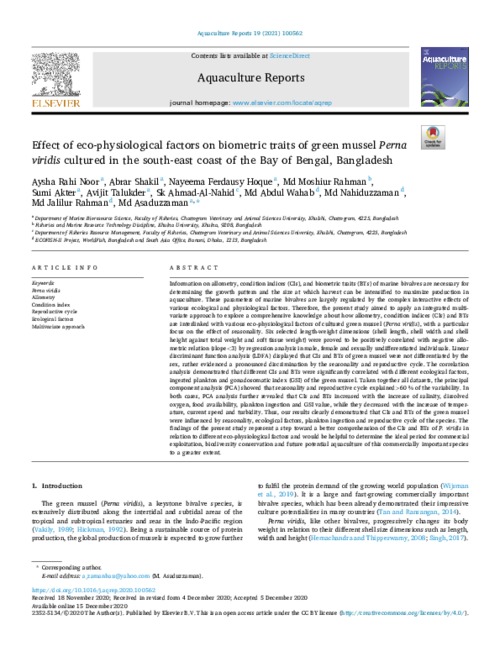Effect of eco-physiological factors on biometric traits of green mussel Perna viridis cultured in the south-east coast of the Bay of Bengal, Bangladesh

Information on allometry, condition indices (CIs), and biometric traits (BTs) of marine bivalves are necessary for determining the growth pattern and the size at which harvest can be intensified to maximize production in aquaculture. These parameters of marine bivalves are largely regulated by the complex interactive effects of various ecological and physiological factors. Therefore, the present study aimed to apply an integrated multivariate approach to explore a comprehensive knowledge about how allometry, condition indices (CIs) and BTs are interlinked with various eco-physiological factors of cultured green mussel (Perna viridis), with a particular focus on the effect of seasonality. Six selected length-weight dimensions (shell length, shell width and shell height against total weight and soft tissue weight) were proved to be positively correlated with negative allometric relation (slope<3) by regression analysis in male, female and sexually undifferentiated individuals. Linear discriminant function analysis (LDFA) displayed that CIs and BTs of green mussel were not differentiated by the sex, rather evidenced a pronounced discrimination by the seasonality and reproductive cycle. The correlation analysis demonstrated that different CIs and BTs were significantly correlated with different ecological factors, ingested plankton and gonadosomatic index (GSI) of the green mussel. Taken together all datasets, the principal component analysis (PCA) showed that seasonality and reproductive cycle explained>60 % of the variability. In both cases, PCA analysis further revealed that CIs and BTs increased with the increase of salinity, dissolved oxygen, food availability, plankton ingestion and GSI value, while they decreased with the increase of temperature, current speed and turbidity. Thus, our results clearly demonstrated that CIs and BTs of the green mussel were influenced by seasonality, ecological factors, plankton ingestion and reproductive cycle of the species. The findings of the present study represent a step toward a better comprehension of the CIs and BTs of P. viridis in relation to different eco-physiological factors and would be helpful to determine the ideal period for commercial exploitation, biodiversity conservation and future potential aquaculture of this commercially important species to a greater extent.
Permalink
Date Available
Type
Publisher
Countries
ISSN
2352-5134
Copyright
CC-BY-4.0
Research Themes
Language